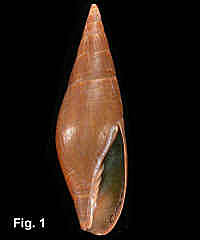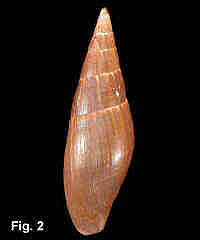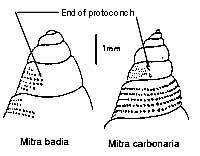|
|
|
||||||||||||||||||||||||||||||||
|
|
Mitra carbonaria Swainson, 1822 Description: Protoconch of 4 1/2 whorls, straw in colour. Shell with straight or concave spire profile, sculptured with fine spiral punctate grooves more prominent on early whorls, and usually absent on the middle of body whorl. Aperture about half total shell length. Columella with 4-6 plaits in adult shells. Outer lip simple, straight, weakly angled, especially posteriorly. Colour dark brown, sometimes with straw coloured axial streaks below the suture, especially on early whorls. Covered with a thick brown periostracum when alive. Size: Adults 44-80 mm in length. Distribution: Australia and New Zealand. In Australia, from Forster, NSW to Westernport, Victoria. Habitat: Under rocks and in cryptic situations on exposed rocky shores, low tide and below. Coleman (1975) reports that subtidally this species lives in mussel beds and kelp forests, and feeds on worms, particularly sipunculids (peanut worms). Common Comparison: There was uncertainty on the identity of the dark brown mitres of southern Australia until Loch (1989) differentiated the species on egg capsule and protoconch differences. He gives the following comparison of Mitra badia and Mitra carbonaria. The diagram at left (from Loch, 1989) shows the protoconchs of M. badia and M. carbonaria.
Synonyms: The synonymy of this species is discussed by Cernohorsky (1976). Synonyms include rhodia Reeve, 1845; digna A. Adams, 1855; contermina Iredale, 1936; sinusigera Laseron, 1951; maoria Finlay, 1927. The species has also been misidentified as melaniana Lamarck, 1811 and nigra Gmelin, 1791. Remarks: The feeding of Mitra carbonaria was investigated by Loch (1987b). He kept M. carbonaria, M. badia, M. glabra and M. cookii in an aquarium and provided diced fish, prawns, mussels and small invertebrates, including peanut worms, to the molluscs. M. carbonaria fed only on the peanut worm Phascolosoma stephensoni. Loch found that it feeds by flattening the tip of the proboscis onto the worm at a random location and making a small hole in the worm body wall. It then introduces its epiproboscis, the thin muscular rod that runs inside the proboscis, and introduces enzymes into the worm for external digestion. M. carbonaria stayed attached for feeding in this way for 2-56 hours, depending on the size of the mitre and its prey. M. glabra, and M. cookii did not feed on P. stephensoni, even after a long period of starvation, but M. badia fed on this species after 98 days of starvation. Figs. 1,2: Long Reef, Collaroy, NSW (C.106189)
|
||||||||||||||||||||||||||||||||


